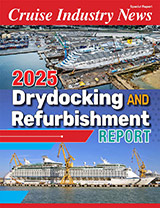The Marseilles Fos supervisory board has approved port strategy and financing to the year 2013, including the transfer of container and dry bulk cargo handling to private operators – a requirement of the French port reform law passed last July.
Management departments drew up the plan after analysis of the port’s strengths and weaknesses in the light of industry trends and following consultations conducted since November between executive chairman Jean-Claude Terrier, trade union representatives and the stevedoring companies. The agreed strategy also takes account of recommendations by the supervisory board, which met three times on the subject after being formed in January, and input from the development board.
An overriding mission statement sets out ambitions to combine environmental responsibility with major growth in annual cargo volumes – from last year’s 96 million tonnes to 120MT by 2013 and 150MT by 2020.
Five main strategic directions are set out under this umbrella – to address the challenge of building container traffic at Fos; to add to the core oil business by increasing throughput of other energy sources; to strengthen the port’s position as a south European hub for dry bulks; to establish a Euro-Mediterranean ro-ro hub; and to further develop passenger facilities.
These aims will be supported by three ‘action policies’ involving investment of EUR600m; an integrated approach to development that optimises economic, urban and environmental considerations; and the priority development of rail and waterways links with the hinterland.
Meanwhile, as well as the handover of container and dry bulk activity to private operators, several other courses of action are to be adopted in line with the reform law requirements and union agreements signed last October.
The oil and chemicals terminals at Fos and Lavera are considered to be of national interest and will be run by a subsidiary in which the port has a majority stake. Maintenance of equipment will come under a company where the cargo handlers are both shareholders and customers, with the port also holding a stake. The port will remain responsible for passenger trades and those areas of shiprepair activity currently carried out by its personnel. In addition, following the closure of the fruit terminal, it is to invite commercial tenders for restoring activity levels in the conventional trades sector.
A three-month period has been set for negotiations with those private operators concerned in the transfer of port personnel and equipment. Under the reform law, the transfer process can take place progressively for up to two years, with a deadline of April 2011. Operators for activities not covered by the transfer negotiations will be selected in a call for tenders to be launched by the port.
This and longer-term action identified under the 2009-2013 strategic plan will run in parallel, led by a four-strong executive board under the control of the supervisory directors. The supervisory board has also approved the executive chairman’s nominations for the three remaining executive posts – his deputy Jean-Pierre Billat, director of strategy Chantal Helman and director of works Renaud Spazzi.
The mission statement
Strategic objectives reflect the ambition of Marseilles Fos to be recognised as a global port, with multi-purpose capacity across 24 activities; a Euro-Mediterranean port, poised at the crossroads of world trade and emerging economies; and a responsible port, able to balance port, industrial and urban development with environmental protection.
The port stresses that such ambitions look beyond the 2009-2013 plan and will not be completed until 2020 bearing in mind the extent of envisaged growth and the current climate of profound structural, cultural and technical changes.
New perspectives
Due to the changes regarding direct control of terminal operations, the plan defines the port’s new terms of reference in three broad areas – ensuring the smooth flow of cargo and passengers; participation with port users in creating added value; and ensuring that the port is economically attractive over the long term.
To these ends, the port will be responsible for safety, security, maritime access and the management of infrastructure; for developing and co-ordinating logistics and industrial initiatives – such as hinterland connections – while managing the environment; and for support activities including marketing, promotion, communications and lobbying.
Five strategic directions
Container strategy hinges on building hinterland traffic. Acknowledging the need to ensure reliability and competitiveness, Marseilles Fos is aiming for throughput of five million teu by 2020 – compared with last year’s 850,000 teu – to be ranked among the top ten European ports. It expects to be ranked 15th by 2013 as against 20th in 2007.
Action highlights include existing schemes such as the Fos 2XL terminal due on stream in 2010, extension of the Distriport logistics zone and completion of a canal link between the container terminals and the inland waterways network. Future projects include the start of work on the Fos 3XL and Fos 4XL terminals before 2013, funded by public investment of EUR200m and EUR300m from the private sector. Road access to Fos is to be enhanced and capacity on the Fos rail network will be doubled via a signal modernisation programme.
Oil sector strategy aims for diversification to position Marseilles Fos as a hub for all forms of energy traffic. Compared with oil and oil product volumes of 67m tonnes in 2008, target throughput has been set at 80MT by 2013 and 90MT by 2020.
Growth will be supported by schemes such as four new refined products berths costing EUR65m, a Shell LNG terminal, a biodiesel plant and extended storage capacity, while a treatment plant is being built to protect the environment from volatile organic compounds discharged during loading of ‘white’ petroleum and certain chemical products.
Dry bulk strategy centres on the need to increase demand for raw materials by attracting industrial investment. Throughput of 13MT in 2008 is scheduled for a 4MT rise by 2013 and an increase to 22MT by 2020.
Alongside new or extended ore and cereals plants, future action also focuses on multimodal and environmental initiatives. These include developing coal and cereals transport by barge or rail, eco-friendly power supply and schemes to reduce waste and power consumption.
Ro-ro strategy identifies a requirement for more services, more investment and faster administrative procedures. The traffic – based in the Marseilles harbour area – is expected to grow from 4MT in 2008 to 5.5MT by 2013 and 7MT by 2020. Representing a two-point gain in market share, this would lift the port from 27th place to among Europe’s top 20 ro-ro hubs.
Investment of EUR24m is planned for the upgrade and development of berths. A further EUR45m is earmarked for a multimodal site under plans to encourage a shift from road to rail.
Passenger strategy addresses the diversity of ships and passenger origins/destinations involved in the port’s cruise and ferry traffic, which by 2020 has been targeted to double from last year’s two million passengers.
Construction of a new berth, lengthening of an existing berth and upgraded passenger access will support growth at the Marseilles-Provence Cruise Terminal, where Costa, MSC and Louis
Cruise have been granted the operating concession. The terminal will also feature a solar power network and – unique in the Mediterranean – quayside electricity supply for ships.
Three ‘action policies’
Investment policy is designed to provide world-class infrastructure through public funding totalling EUR600m in the period to 2013. Over the same period, the port expects this initiative to generate private sector investment of EUR3 billion.
The EUR600m includes EUR100m of state finance and EUR65m from regional authorities.
Within the total, EUR361m relates to schemes agreed before this year, while the remaining spend will be evaluated by the supervisory board in the light of evolving global economic conditions.
Publicly funded investment amounts to EUR315m in the container and logistics sectors; EUR87m on energy and other liquid bulk trades; EUR18m on dry bulks and industry-related schemes; EUR82m on ro-pax facilities and the port/city interface; and EUR98m for development support projects such as pre-post forwarding, dredging and environmental management.
Development policy aims to reconcile best use of the port’s unrivalled land bank – 350 hectares at Marseilles and 9,000 hectares at Fos – with respect for the ecology and urban populations. Among initiatives, the port aims to buy land for public use to compensate for areas developed for commercial purposes. Industrial development will be sympathetically located and incorporate eco-friendly synergies. The port will also continue to take a lead role in the public consultation process.
Hinterland policy sets out to offer a multimodal logistics network giving Marseilles Fos better links to northern Europe than its Mediterranean rivals – notably by supporting rail and waterways modes as the preferred alternative to road transport. By 2013 the port wants waterways traffic to rise from 4.7% to 10% of throughput, rail to take 30% instead of 13.7% and road volumes to fall from 81.6% to 60%.
Among action envisaged, the port will seek capital stakes in inland trimodal hubs while also enhancing its own multimodal platforms; support new inland and Motorway of the Sea services; offer incentive tariffs; and work to improve cargo flows through tracking and simplified customs procedures.



